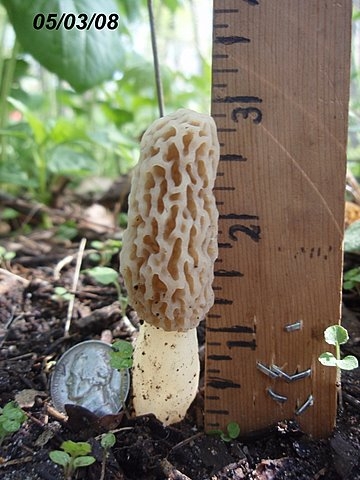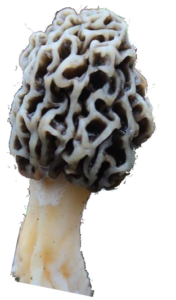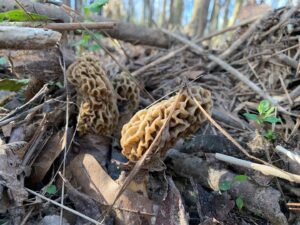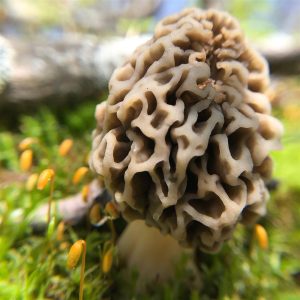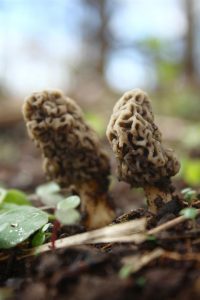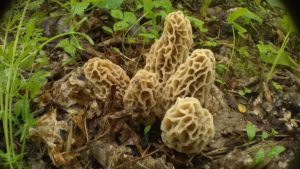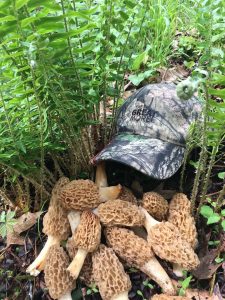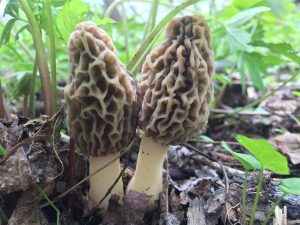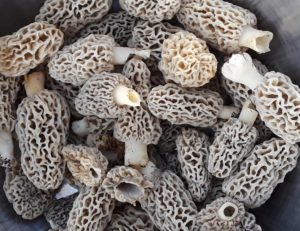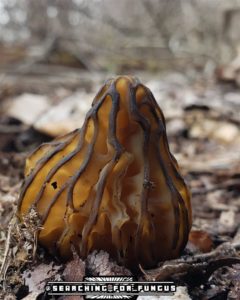These are a few of the most frequently asked questions 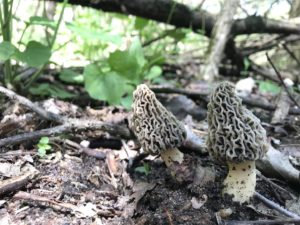 relating to the morel mushroom. From hunting and harvesting, to cultivating them yourself – consider it an attempt to disclose some of the mysteries of the often elusive morel. Many of the questions are geared toward shroomers who are new to the experience, others are questions even the most seasoned hunters often times continue to ask themselves.
relating to the morel mushroom. From hunting and harvesting, to cultivating them yourself – consider it an attempt to disclose some of the mysteries of the often elusive morel. Many of the questions are geared toward shroomers who are new to the experience, others are questions even the most seasoned hunters often times continue to ask themselves.
If you do not see the answer to a particular question you may have then check out The Great Morel’s Social Media platforms where morel enthusiasts gather to share information, knowledge and more.
As The Great Morel says…
“they remain a mystery to many of us”.
![]()
FAQ Index
- Do morels grow in my region of the United States?
- When is the growing season in my region?
- When should I start looking and where?
- What effect does the weather have on the morel’s growth habits?
- How come I can’t find them?
- How can I find help Identifying Trees?
- Does the source of the spore that produces the morel die out?
- How do morels make their grand appearance to the world?
- How fast do they grow
- What type of equipment do I need to get started?
- What type of collection bag should I use?
- How long is the life cycle or how do I know when I should pick them?
- How should I harvest them?
- How long will picked morels stay fresh and how should I store them?
- What is the best way to preserve my morels?
- Are there places I can purchase fresh morels from?
- How should I package for shipment?
- Can I grow or cultivate the morel myself?
- What is the most common way of cleaning and preparing prior to cooking?
- What if any, is the nutritional content of the morel mushroom?
- How can I help identify my morels if I am not sure?
- Is there a way of identifying the False Morel?
- Don’t see your question? Pop on over and visit one of The Great Morel’s Social Meida pages.
![]()
-
Do Morels grow in my region of the United States?
This is an often-asked question and with the exception of a few geographical areas, the answer is more than likely -yes. However, while it seems the Great Lakes region in the Midwest is the hot bed for the morel, the morel is found in most regions of the US with the exception of the desert and deep southern coastal areas. The Great Morel suggests that you contact your area’s nature and wildlife department for assistance as an added information source. You can also check out The Great Morel’s sighting maps to see when your region is having harvesting activity. While there are many places where the morel is not natural to the geography, it also is not uncommon to find them in mulch beds for what The Great Morel refers to as “landscape morels”.
Also read the blog post on Morels in the Various Regions of the US. It goes into detail about specific regions of the US and the unique challenges these regions face when seeking the morel.
Return to FAQ menu
-
When is the growing season in my region?
This will depend on your geographical location. The morel season for most of the United States typically runs from early-to-mid April on through mid-June. Depending on your geographical location, your season could be plus or minus a week. The season will typically kick in about mid-April in the Great Lakes region. If you are uncertain, contacting your state’s nature and wildlife department for assistance is a good idea if you can’t find anyone to assist you. For the true timing of morels in your region and the progression of the morel, you need to check out The Great Morel’s sighting maps to see if they are popping in your neck of the woods. The sightings map is a pretty good reference to the season for the various regions of the US and these are updated daily during the morel season.
Return to FAQ menu
-
When should I start looking and where?
Great question. Narrow down your region’s season for starters. Assuming you read the question above, once you have determined that “yes” they are out there then the adventure begins. Many seasoned hunters have their favorite areas. Dead or dying elms, old apple orchards, old ash, poplar trees and yes even pines. It truly can be a hit and miss adventure at times. Not every elm you cross will have morels around it so don’t get discouraged. Depending on your region, you may have to look harder than others. Often times morel hunters have a particular type of wooded growth that attracts them as a hunter, and this comes with experience and lots of trial and error….and often times luck!
For those who are unfamiliar with the importance of tree identification slip over and read The Great Morel’s blog post on “The Trees of the Morel“. The Arbor Day Foundation also has this great page to get you started in tree identification .
If you are just beginning morel hunting, see if you can find someone who will let you tag along and have them share their tips and tricks of the trade. One final note: read the blog post “5 Tips For Finding More Morels” for additional tips and suggestions.
Return to FAQ menu
-
What effect does the weather have on the morel’s growth habits?
The Great Morel is pleased to provide actual scientific data on this subject and most seasoned hunters will agree that YES the weather – more than any other variable has the most impact on the morel season. This includes air and ground temperatures along with moisture levels in the ground. Read the blog post on the Life of The Great Morel which discusses the morel’s battles with Mother Nature. Typical spring weather with daytime temperatures moderating between 60-70 degree range and nighttime lows of not less then the mid-40’s are usually ideal. Too much soil moisture is not a good thing nor is too dry of soil. Again, it’s tough to determine at what point rain levels are too high, but too much rain can sometime have a negative effect. Not enough rain is definitely not good for the morel either. Soil temperatures will typically range from 50 to 60 degrees. It is not uncommon to find morels after a light frost or even snow, however, it is most likely that the morel had already made its grand appearance prior to the snow.
If you are still really curious, click on over to the Growth Cycle page and check out a few of the growth studies. There is one study contributed by Scott M from Illinois who captured the effects of Mother Nature on a morel patch which is interesting to see. You can also check out the links of the various sites relating to weather and soil conditions on the Weather, Soil, and Trees Links page.
Return to FAQ menu
-
How come I can’t find them?
This is a tough question for any morel hunter to answer and who hasn’t or doesn’t ask this question? Yes, even the most experienced hunter wonders this at times. If you’ve read any of the above FAQ’s you should have the understanding that there are lots of variables; your region, 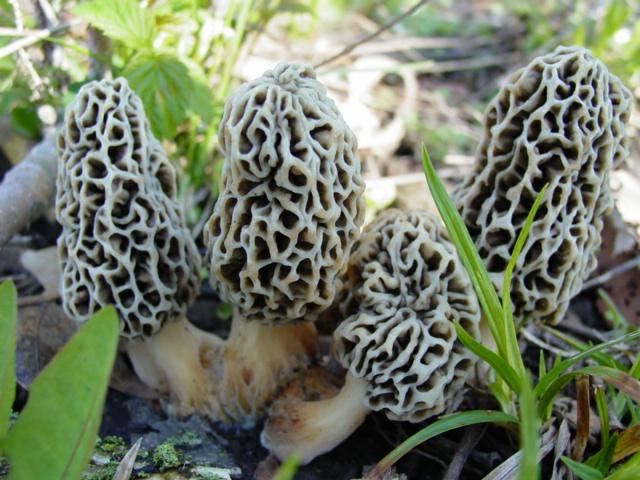 your season, the weather, timing, and maybe the most mysterious is the spore that produces the morel. Not every area you venture into will have that patch waiting for you so keep searching. Often times hunters will continually search an area that has produced in the past and for reasons sometimes unknown, they will come up empty. As stated before, this too is the mystery of the morel. If you are interested in the scientific aspects of the morel, then venture to the Info and Links page and visit some of the great scientific web sites that delve into greater details of mycology.
your season, the weather, timing, and maybe the most mysterious is the spore that produces the morel. Not every area you venture into will have that patch waiting for you so keep searching. Often times hunters will continually search an area that has produced in the past and for reasons sometimes unknown, they will come up empty. As stated before, this too is the mystery of the morel. If you are interested in the scientific aspects of the morel, then venture to the Info and Links page and visit some of the great scientific web sites that delve into greater details of mycology.
Return to FAQ menu
-
How can I find help Identifying Trees?
Aaahhh, the trees. It seems most, if not all morel enthusiast make reference to a certain type of tree. So how do you learn to identify which tree is what? How can I tell which is an elm, an ash, a poplar, an apple, or a sycamore? The Great Morel published a blog post article called “The Trees of the Morel” so check it out first. Then check out the tree experts at Arbor Day Foundation. You can visit Arbor Day Foundation Tree Identification page by clicking here. Here you can find wonderful images displaying the characteristics of the trees so many morels hunters refer to. It is recommended by The Great Morel to spend some time and learn the trees of the morel and get to know them. Pay particular attention to the characteristics of the bark on the trees, since most of the trees in the early spring do not have mature foliage and identification of the leaves may prove difficult.
Another useful tip is to contact the Agricultural Extension Agent in your region who can assist in identifying trees in your particular geographical area. Much of a morel hunters knowledge of tree identification comes over time. It is a common process for most shroomers to survey the area and analyze the vegetation around their morel patch – most importantly the trees. Overtime, your knowledge will increase and you’ll spend less time wondering and more time harvesting.
Also check out The Great Morel’s Weather, Soil, and Tree links page for additional information and visit the Tree and Bark photo gallery.
Return to FAQ menu
-
Does the source of the spore that produces the morel die out?
Not that The Great Morel professes to be an expert in the study of spores, but after many, many years of hunting, and doing research, rest assured the source of the spores which brings your patch to life every spring will eventually pass along.
First off, if you have any experience at shroom’n you very well know there are no guarantees. Let’s first look at what creates the morel in the first place – the spore. As stated, The Great Morel is not a Mycologist therefore, it is not the intent delve into the scientific realms of the spore – if you want a more scientific explanation then see the above question and refer to the Info and Links page and visit some of research related sites.
The source of the spore is often the root cause of the mystery that surrounds the morel itself. The source of the spore can come from many places. Often times from some sort of underground root system; or they may have gotten there via airborne transplantation. Very often it is hard to determine the exact source of the spore. Many shoomers will look around after finding a patch and say “its that elm tree” or something to that nature. Whatever the source of the spore, when it ceases to exist – so do the morels.
The spores from the fungus drop from the “holes” in the cap, other mushrooms have gills under the cap. After these microscopic spores have dropped mycelium begins to grow under the ground in the first inch or two of dirt mainly on wood chip/decomposing wood and it needs high humidity and a good temperature. Most mushroooms need a temp of 79-82 degrees F but with morels it is believed it is 50-75 degrees due to them coming out in early spring. After the mycelium has colonized 100% of the substrate it’s growing on/in it will begin to create fruit body from the mycelium and the mushroom itself actually grow in about 3-10 days depending on size, conditions, weather, moisture, whole list of variables. The mycelium needs a few things to grow the right temp, right decomposing wood, right moisture content, high humidity, and shade.
There is also the theory among some morel hunters that morels will replenish or re-populate within the same year. You may very well hear some seasoned shroomers swear that “where you find grays, you’ll find yellows” within the coming weeks. The Great Morel has not uncovered any scientific data to back this particular theory. However, it might not be uncommon for you to stumble across a section where the morels and the spores may be in different stages in their life cycle. This may cause them to seem as though they are re-appearing or re-populating, when in actuality some of those morels may not have made their grand appearance on the day you happened upon them. If such is the case, then this theory is explainable and may be valid, but other than the circumstances mentioned above, there is no data to support the natural succession of a patch of morels from one week to another, or that a patch will produce one variety followed by another variety.
Along the same lines – many of you have had your favorite morel patches, which have just dried up so-to-speak. Those “sweet spots” that are no longer “sweet” anymore and you think they’ve been “picked into extinction”. One has to understand that something in the biological and ecological makeup of that patch has changed. Did the spores that spawned that patch get blown there? Has the root system or the ground composition changed? Did something else change? Have they actually been “picked into extinction”? Based on basic research, it is most likely there has been a biological or ecological change, which has caused your morel patch to no longer be bountiful. Simply put – the source of the spore is no longer capable of propagating the great morel.
For more on spore re-distribution check out the page Growing Tips page for more on this topic.
Return to FAQ menu
-
How do morels make their grand appearance to the world?
POP!!! No, just kidding. Rest assured everyone, that is a shroom’n theory as old as dirt. It is believed and proven by most that the morel fungus will sprout (so-to-speak) as any other living organism and proceed in a progressive growth pattern. There are a few very good sites out there which break down this biological process in great depth, of which The Great Morel will refrain from doing. The Great Morel has never attempted a study of its own and therefore, it can only gather data from other sources – of which many can be found on the Info and Links page. Many us have found them curled up as if they didn’t quite stand up nice and tall, or got hung up by a root while trying to stand erect. Why so? What actually happened in this morel’s short but wonderful life? In a way, maybe we don’t really want to know the answer to this question. Maybe knowing will erase some of the mystery that surrounds this spring pastime. Just rest assured they don’t just POP!
If you are still really curious, click on over to the Growth Cycle page for more on this subject. Also, as mentioned earlier…read the blog post on the Life of The Great Morel which will offer additional insight.
Return to FAQ menu
-
How fast do they grow?
Now The Great Morel can back this with more than a theory. A few years back, The Great morel spotted three small grey morels (the 3″ variety) after repeatedly checking on a known patch. Thus placing small sticks beside them, and monitored them over a three-day period. The results at the end of the three-day period were as follows. One of three grew a total of one half inch.
A second one grew just under a half inch and the last one showed growth that was almost immeasurable. So with this scientific study in hand – yes they do grow.
However, growth rates may vary based on when the morel you’ve found made its grand entrance into the world. Don’t exclude those other variables such as weather and ground conditions. In closing, unless you are certain no one else will pick your crop, pick and bag them!
Click here to see images of The Life of a Morel that were taken by Mike Wolfe, a well renowned shroomer from north central Indiana. Mike took these images of a small grey morel over a 6 day period and once again is proof that depending on when you first spot the morel, they do in fact grow.
Also check out the for advice and studies others visitors to The Great Morel have sent in.
Return to FAQ menu
-
What type of equipment do I need to get started?
Not much! A bag to carry your prize out of the woods, a decent hiking stick and you are on your way! There is debate among shroomers on what type of bag or sack one should carry. It seems the most highly recommended is an onion bag of some kind or a mesh bag. For several reasons, one being it allows your morels to breath thus keeping them fresh and lets some of the little critters fall out. Some believe this also allows the spores to disperse out of the sack and replenish the woods (just a theory as far as The Great Morel knows). Pillowcases are good too, yet you’ll bring those critters home with you then. Plastic bags are not highly recommended. If you are harvesting them by the pounds, you may want to think of keeping a bushel basket in the car! For other suggestions on equipment see equipment list on the Humor page. You can usually round up most of what you need from the closet, yet if you are looking to sport the latest in fashionable morel gear to impress all your shrooming friends, then check out the The Great Morel Store
It is also suggested by many to protect yourself against ticks. Visit the Into the Woods page and see the detailed sections on ticks and poison ivy
Return to FAQ menu
-
What type of collection bag should I use?
There are many who believe you should use a mesh or onion bag to help in the distribution of the spores back to the forest floor. The Great Morel knows of no pure scientific data to support this.
However, Gregg Kathol (a renowned and legendary shoomer in his neck of the woods) did some research and reported the following:
“I did a little research on the subject and came up with some interesting tidbits. I guess the spores can be compared to pollen. It takes hours for the spores to fall to the ground, so with even a slight breeze they can be blown miles away. I also learned that by the time a person picks them they have lost most of their spores anyways. Same thing for the roots being picked. I learned this is a story because the growth of the shroom is a one time process. These are just some things I found out, whether they are backed by 100% scientific data, I do not know. I’ll continue to carry them in a mesh bag because I figure even if they get blown away at least they are going to the ground and not in my sink or house.”
The Great Morel would find it hard to disclaim such research, so it is left to the shoomer. Keep in mind however, as stated in the question above regarding the spore source – the spores from the fungus drop from the “holes” in the cap, other mushrooms have gills under the cap. After these microscopic spores have dropped mycelium begins to grow under the ground in the first inch or two of dirt mainly on wood chip/decomposing wood and it needs high humidity and a good temperature. Most mushrooms need a temp of 79-82 degrees F but with morels it is believed it is 50-75 degrees due to them coming out in early spring. After the mycelium has colonized 100% of the substrate it’s growing on/in it will begin to create fruit bodys from the mycelium and the mushroom itself actually grow about 3-10 days depending on size, conditions, weather, moisture, whole list of variables. The mycelium needs a few things to grow the right temp, right decomposing wood, right moisture content, high humidity, and shade.
If you are looking for a great mesh bag – check out The Great Morel Store and order yourself one.
Return to FAQ menu
-
What is the life cycle or how do I know when to pick them?
You usually you can tell when they start to look unhealthy or they are announcing “pick me” by examining the cap (or head) of the morel as well as the base of the stem. You will typically find the morel begin to darken along the stems as well as the cap as it ages. The amount of discoloration is 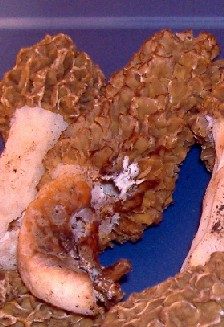 a good indication as to if the morel is on the down side or not. Slight decay and discoloration is by no means reason to feel failure in your timing as a shoomer. It may or may not make the morel a “bad” morel, because often times you can trim the bad spots off of them when cleaning and preparing. Again, depends on how far along this decaying process is.
a good indication as to if the morel is on the down side or not. Slight decay and discoloration is by no means reason to feel failure in your timing as a shoomer. It may or may not make the morel a “bad” morel, because often times you can trim the bad spots off of them when cleaning and preparing. Again, depends on how far along this decaying process is.
It is not all uncommon for the tips of the caps to be missing either. It is usually the weakest part of the morel as it stands in the sun or begs for rain or your morel is crying because it has been bitten by a cold night frost. So do not be alarmed if it has sprung a leak in the top of the cap. If the rest of the morel looks fresh and healthy, then pick it and trim the bad stuff off later. Many morel hunters will use a 50 percent factor….if 50 percent is good then it’s worth bagging. Take a closer look by clicking on the image or clicking here and you’ll get a better idea of what to look for.
About the life cycle and the morel’s characteristics as it starts to age. With the cooperative weather conditions the morel can survive for up to two (2) weeks before the natural decay process is likely to set in and begin to take place. Again, the weather has so much do with the life cycle and most morel hunters will agree it is by far the most important factor. If you are looking for a more scientific explanation, visit Tom Volk’s website in which he shows a wonderful graphic of the morel life cycle from a scientific perspective.
Return to FAQ menu
-
How should I harvest them?
Many believe you should pinch the morel right at ground level. Of course one could use a knife or a chain saw depending on how big, but a simple pinch and twist will usually do. There are several reasons for this. One it helps keep dirt that is on the root from making a mess of the rest of the morels in your bag. The other reason which again is another theory, but it is believed that by leaving the root you are assuring that the patch will reproduce next season. (also see the question above)
Return to FAQ menu
-
How long will picked morels stay fresh and how should I store them?
This often asked question will depend on how long you plan on waiting until preparation and how many are destined to be prepared. Let’s start from the beginning shall we? See the question above on “How should I harvest them?” for starters. Then see the question below on “What are the most common ways of cleaning and preparing prior to cooking?” Once you get them home The Great Morel simply suggest rinsing thoroughly in water and halving the morels (cutting them lengthwise in half), at which point you should rinse again. Some may suggest soaking in salt water to kill off any critters, 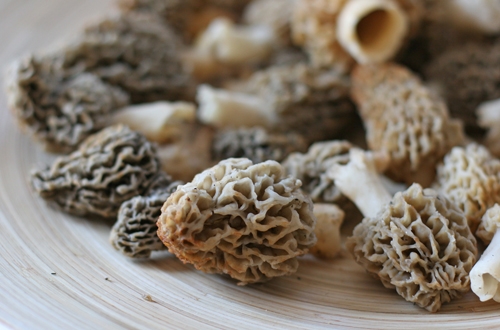 but not always necessary. Once rinsed it is suggested you place your morels in a large bowl or bowls and cover either with a damp paper towel or a damp scent free cotton cloth. Then simply place in your fridge. The Great Morel used to leave them soaking, but suggestions from other shroomers changed the game plan slightly. At least once a day re-dampen the towel just to keep them moist. (note: if they start to dry up, a short dip into water re-hydrates them nicely)
but not always necessary. Once rinsed it is suggested you place your morels in a large bowl or bowls and cover either with a damp paper towel or a damp scent free cotton cloth. Then simply place in your fridge. The Great Morel used to leave them soaking, but suggestions from other shroomers changed the game plan slightly. At least once a day re-dampen the towel just to keep them moist. (note: if they start to dry up, a short dip into water re-hydrates them nicely)
When prepped in this fashion The Great Morel suggests using and abusing them with the frying pan within one week. Some shroomers may say “that is too long” while others will say you may keep them longer. As a safe rule of thumb and to guarantee freshness…use the one (1) week rule. They’ll be happy you did and so will you.
If you are looking at preserving your morels for a longer period of time, or you have more than can fit in your fridge, then it is suggested you check out the Preserving page for some of the great ideas from other morel hunters. Also read the “Complete Guide to Preserving Morel Mushrooms” blog post which goes into great details about the various techniques to preserve.
Notes: Salt water is acceptable by some and not by others. Those opposed say it makes the morels too salty. So if you choose salt, don’t let them soak too long. Also the above technique is making the assumption that the morels in hand are fresh from the start. Often times we find them a day or two late in which case you should lower the one week rule by days accordingly. Use good judgement as you would with any other food you are storing in the fridge. Unfortunately, morels are not found with a “born-on-date”.
The Complete Guide to Preserving Morels
Return to FAQ menu
-
What is the best way to preserve my morels?
Aaahhhh….everyone wants to make keepers out of them huh? Extend their usefulness well past the season? Click here and check out The Great Morel’s Preserving page for lots of different ways to pack them away for an out-of-season rainy day.
Also check out The Complete Guide to Preserving Morels which details several proven techniques.
The Complete Guide to Preserving Morels
Return to FAQ menu
-
Are there places I can purchase fresh morels from?
Absolutely! The Great Morel will point you in the right direction and all will be good after a couple clicks of the mouse. Start by heading over the Info and Links page and check out the section on Stuff for Sale Links and review some of these sites. The Great Morel does not endorse or get kickbacks from any of the sites listed, however, if you patronize them, tell them The Great Morel sent you and ask them for The Great Morel Discount.
Return to FAQ menu
-
How should I package for shipment?
This is as much a mystery as the great morel itself and there are a lot of people requesting best ways. Here are a few suggestions that have been offered to The Great Morel.
1) Thoroughly clean and wash your morels and package them along with a moist paper towel into a zip-lock bag. Remove as much air as possible. Pack ’em and ship ’em.
2) Others have said they punch holes in priority boxes and send them just in the box (pre wash & slice).
3) Yet another suggestion was to package them with paper to absorb any excess moisture and express mails overnight.
This suggestion comes from Linda in Montana after a few failed attempts to mail them to her parents in Illinois:
We had a box (guessing 12x18x4 inches) and we created 15 individual compartments by cutting thinner cardboard, like a poster board and notching them so they were “connected” and placing these in the box. We lined the bottom of the box with newspaper, divided the total of the morels into the 15  compartments and placed a paper towel on the top of each compartment. We crumpled the pieces of paper towel a bit and simply put one on top of each compartment. Then we closed up the box and mailed it! If it had arrived on time, none of the morels would have been lost.
compartments and placed a paper towel on the top of each compartment. We crumpled the pieces of paper towel a bit and simply put one on top of each compartment. Then we closed up the box and mailed it! If it had arrived on time, none of the morels would have been lost.
This way is by far the best way I have tried. In fact, I don’t think I need to experiment further. I will add though, that the fresher the morels the better. We sent these off the day after my husband picked them, so they were firm. – Courtesy of Linda in Montana
Here are some tips from Anna Simmons in Wisconsin as she had good success while sending them to three various regions of the US:
Unfortunately (or fortunately, depending on how you look at it) I hadn’t read your page before I shipped a bunch of Morels to my mother and my step-mother for Mother’s Day, so I relied on experience with other forms of highly perishable produce (like strawberries) which do better if not washed until directly before use. So I loosely packed the unwashed Morels in paper bags folded closed, placed in shipping boxes (along with Mother’s Day beanie babies) and sent them USPS Priority. One went to near Pittsburgh, PA and the other to Stuart, FL. I also sent some to my sister-in-law, but by then I’d read the “shipping instructions” and washed them and sent with a damp paper towel in a zip-lock bag.
The results are as follows:
The Mother’s Day shipments were sent on Thursday. The Pittsburgh shipment arrived on Saturday and in excellent condition. My mother said they looked great. The Stuart FL shipment was delayed and didn’t arrive until Monday, but in the same condition, just fine.
My Sister-in-law’s shipment was sent Priority to Lakeland, FL on Saturday AM and arrived on Monday also, but because the mail carrier had a walking route and therefore carried them around for much of their 90 something degree day, (they’re in the midst of a drought) they were quite warm, almost as though they had been cooked. We figured they’d likely be OK once she washed them up, as long as she cooked them well. Her next shipment will be of Dried Morels…Thanks a lot for your site, it was a real help to me! – Courtesy of Anna S. in Wisconsin
Tips for mailing frozen morels from Hugh in Maryland:
We did not do this this year, but in years past, what we have done is, use dry ice (from Baskin-Robbins), and packed the frozen, breaded morels in a styrofoam cooler. The morels spent two days on the road and emerged fine (still frozen). – Courtesy of Hugh in Maryland
The Great Morel’s only sound advice is this…ship them the fastest way possible, and upon arrival make sure the recipient inspects them for freshness and cleans them well.
Return to FAQ menu
-
Are there ways to grow or cultivate the morel myself?
We’ve all wondered this from time to time. The Great Morel is open to truthful answers to this often-asked question. Until recently, few have reported much success. However, as of late, mycologists and morel enthusiasts have taken this question and answered it. New levels of research strongly suggest that the answer may very well be yes, with really good success rates.
If you haven’t already, you can check out the morel growth cycle page and get a better understanding of the morel lifecycle. Also, read The Great Morel’s blog post on The Science of Morel Mushrooms, which takes a deep dive into morel cultivation and more.
John Burch, a renowned morel hunter originally from Iowa had this to add:
You can grow your own mushroom patch!
When I was a kid, my mother used to soak our morels in salt water to clean the dirt off of them and kill the bugs. Then my brothers and I would throw the water on an old stump or around our favorite tree with the hope that we were planting a mother-lode patch for the next year! I guess we did not realize that the salt was killing the spores because we never had any success.
My lifelong friend Tom has never put salt in his mushroom soaking water and began dumping it on several areas of his yard in the early 2000’s – under a line of pin oaks and under an old dead elm near his chicken coop. He has been picking mushrooms in his yard for over 20 years! He waters his patch in dry years to perpetuate his crop and always gets a mess or two to eat – even in years when no one else is finding shrooms.
The best part of it is that he has “old” shroomers – Grandma and Grandpa who can no longer make the trip into the timber come hunt for them in his yard and it is quite a thrill to see their faces light up when they find em.
Have a Blessed Day my friend
Below are some of The Great Morel’s favorite sites regarding this infamous question.
- Check out this great page from the people at TheFarm.org: This technique was developed by mycologist Gary Mills after much trial and error, and observations of morels growing in nature. What follows is a sequence which Gary demonstrated for the PBS series, Scientific American Frontiers. The temperature, humidity, substrate and other detailed parameters were placed in the public domain by George Robert Trager. While this post is old, it is good stuff for those truly interested in morel cultivation.
- The Great Morel rarely endorses products, however, new studies and testing have made advancement on self cultivating. Sadly, one of those groups was Edge&Osborn from howtogrowmorelmushrooms.com who’s work as of 2025 is on pause and both web pages are down. Their hope after experimenting for 10 years was… “Morel cultivation has been around for a long time. A recent finding in the spawn making process has given us the breakthrough needed to provide seed that will work given the right care and environment.”
- If you are entertaining the thought of starting your own morel garden right out your back door, then you may want to consider visiting these various websites. Fungi Perfecti, which is a family-owned, environmentally friendly company specializing in using gourmet and medicinal mushrooms to improve the health of the planet and its people. They also market several growing kits, with books and needed materials. Another site to visit is BuyMorels.com which offers a morel growing kit with other items. Also, visit Gourmet Mushrooms and Mushroom Products for “The Morel Habitat Kit” which was developed so everyone could enjoy growing their own morels” and other products.
- One may want to check out Thomas J. Volk’s article on “The Morel Life Cycle.” Thomas J Volk is a well recognized expert in the field of mycology and a member of the Biology Department at the University of Wisconsin-La Crosse. He has a well written piece on morel cultivation which attempts to answer some of the mysteries as to why it is so difficult to repeat this magic of nature.
- Michigan State University is on the forefront in the biotechnology arena as it uses its research and high-tech laboratory to mass produce the ever elusive morel. To quote their news article posted on their website….”DNP has used science and entrepreneurism – much of it from MSU – to transform an abandoned bean cannery in the fields of northwestern Michigan into a high-tech biotechnology plant and laboratory.” You can check out the University’s News Release Biotech brings mushroom hunt indoors for the news article. Unfortunately, the original web page which had detail of the project, along with amazing images is no longer available.
- The website of MorelFarms.com has a patented process for morchella cultivation, developed by Stewart Craig Miller, a native of Lafayette, Indiana. This website offers trees for sale that have been inoculated with the morel fungus. The discovery is protected by Patent for “cultivation of morchella and cultivation of morel ascocarps respectively. Morel cultivation is briefly outlined in this website and is described in detail in the patents.”
- You may also want to check out the YouTube video from Myra Dean called “Growing Morel Mushrooms” where she explores her journey of cultivating morels. The Great Morel believes this is worth checking out!
The Great Morel is not making any endorsements or getting kick-backs from any sites mentioned above, however, tell them you found them on The Great Morel and let The Great Morel know if you have success.
Return to FAQ menu
-
What is the most common way of cleaning and preparing prior to cooking?
Why there is not a set procedure for cleansing and storage here are some suggestions that may be most common. Once you’ve got your catch back home, its bath time. Take them to the sink and rinse them with cold water to remove any loose dirt and foreign particles. For newbies to morel hunting, foreign particles also include bugs, so do not be alarmed or disgusted. This is more easily done by slicing the morel lengthwise into halves.
This next step is optional and may not need to be done. Once you’ve rinsed them thoroughly, fill the sink with cold water and add some salt to the water. Drop your morels into the 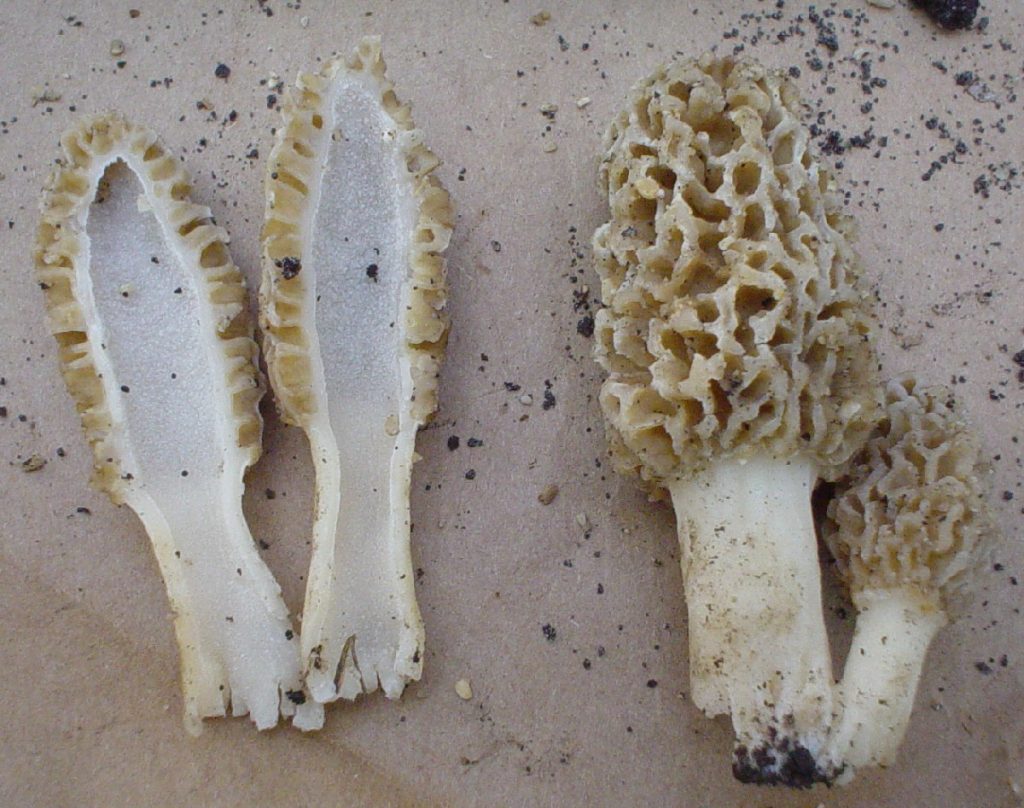 sink and soak your morels in a lovely salt bath. Often times they love this. Note though, this is only needed to help bring the critters out of the morels. How much salt you ask? This is debatable and some shroomers will advise to skip the salt all together because your morels will absorb the salt thus damping the true flavor. Needless to say, over salting is not recommended and if you feel your morels are critter free then pass the salt bath. If you’ve chosen to delight your catch with the salt bath, don’t let them sit for more than an hour. Not that they start to wrinkle, they just want to get out of the pool.
sink and soak your morels in a lovely salt bath. Often times they love this. Note though, this is only needed to help bring the critters out of the morels. How much salt you ask? This is debatable and some shroomers will advise to skip the salt all together because your morels will absorb the salt thus damping the true flavor. Needless to say, over salting is not recommended and if you feel your morels are critter free then pass the salt bath. If you’ve chosen to delight your catch with the salt bath, don’t let them sit for more than an hour. Not that they start to wrinkle, they just want to get out of the pool.
The next steps depend an awful lot on how quickly you are going to begin your feast. If you are going to cook them up right away, then go for it. Assuming you are planning on cooking them up and you are uncertain when and how, then check out The Great Morel’s recipe page and continue on. If you are planning on preserving them then that is a different story, so stop here and check out the Preserving page and the The Complete Guide to Preserving Blog Post. Assuming your planning on feasting soon, pull out a large bowl or storage container and begin layering the morels in the container. Some people will layer package with a moist cloth or moist paper towel separator between layers. Its been reported using paper towels will often times transmit a paper towel flavor to the morels. So if you are a bit fastidious, use a cotton cloth. It is recommended to keep your morels moist (not soaking) and then cover them with a moist paper towel or cotton cloth. Since morels do not come with “born-on-dates” it is recommended not to store more than three to four days before preparing, although there are those who will say they will stay good for a week. Keep the cloth covering the bowl moist and it is not unheard of to periodically fill the bowl with water and drain and stick back in the fridge.
Again, these are suggestions. There are many shroomers who have their own procedures, which have been handed down from generation to generation. Keep in mind these are tips and if you have variations then no big deal. Find what works best for you and do it.
Return to FAQ menu
-
What if any, is the nutritional content of the morel mushroom?
This is a great question, which many visitors ask in concern of diet for various reasons. In researching the nutrient value of the morel mushroom, it is very difficult to find a great deal of validated information. The USDA National Nutrient Database for Standard Reference website is as good a place to start as any. While the morel is not listed when searching this site, you will find a variety of other mushrooms in which to make your own conclusion. Search for “mushroom”. This website may be your best bet though.
You can also check out the USDA’s website and review this PDF file of . Note: this publication was last revised in 2002, yet contains valuable nutrient data on page 86.
There is a good blog post article posted in 2020 on the Health Benefits of the Morel Mushroom which is a must read – lots of good stuff.
Some retailers who offer dried morels label their products with respectively similar data. For instance, one such retailer states that 0.5 oz of dried morels contains about 48 calories, 3 calories from fat, total fat of 0.25g, sodium 3mg, total carbohydrate 8g, and 3g of protien. 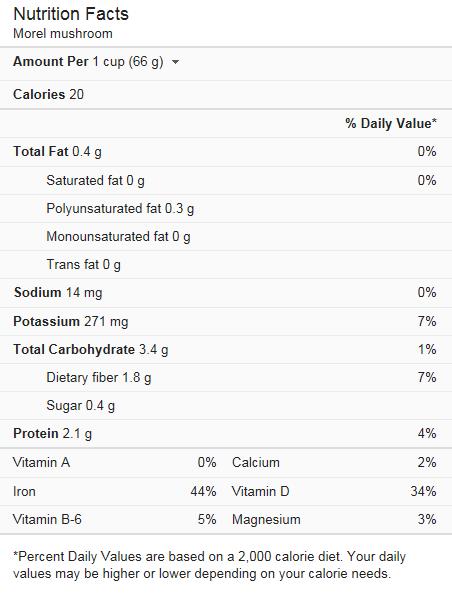 Albeit comparable, another such retailer offers a slightly different set of data – stating 84 grams of morels to have 20 calories, 2g of protien, 3g of carbohydrates, 0g of total fat and 0 grams of fiber.
Albeit comparable, another such retailer offers a slightly different set of data – stating 84 grams of morels to have 20 calories, 2g of protien, 3g of carbohydrates, 0g of total fat and 0 grams of fiber.
It is reported by some to be low in fat and high in fiber, while containing several types of vitamins, however, as stated it is very difficult to support the specifics to this data. Wikipedia, the free encyclopedia website reports substantial and detailed nutritional data on the mushroom in general. You can visit Wikipedia’s mushroom page by clicking here. The FDA has very little in regards to nutrient data on the morel mushroom. Hopefully, in the future there will be more extensive data regarding nutritional value of the morel (morchella) mushroom.
Return to FAQ menu
-
How do I identify my morels if I am not sure?
The Great Morel takes this question very seriously and cannot answer it knowingly without holding your morels in hand. If you’ve checked out the photos on the Varieties page, you should have a pretty good idea of what a “good” morel looks like. However, if you are still uncertain as to what it is you are trying to identify, below are links to a few of the really great sites, which may be able to help you. With white papers, excellent images and enough scientific data to satisfy most research projects. The Great Morel strongly suggests any one who is in doubt to pay a visit to these sites. These are very informative and should enhance your knowledge. The Great Morel still suggests caution even after reviewing these sites.
The Great Morel’s False Morel Page – this is not a scientific research page, but more a page to help you get a beginners understanding of the False Morel and the dangers this bad boy can pose. Think of it as a starting point to understanding and identifying the False Morel.
Mushroom-Expert.Com – a newly established project dubbed the “Morel Data Collection Project.”
Spring Morels and False Morels of Midcontinental U.S. – a fantastic white paper by Donald M. Huffman and Lois H. Tiffany on identifying morels.
Edible and Poisonous MUSHROOM Page – a great source of information on identification.
Click for Additional Information and Resources
- Into The Woods
- The Edible Good Morels – Varieties
- The Morel Season
- The Trees of the Morel
- The Complete Guide to Preserving Morels
- Articles and Posts on Everything Morels
- Top of Page

